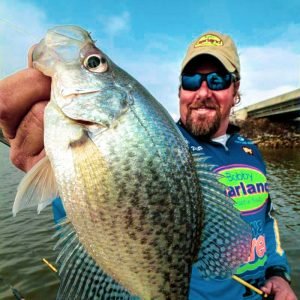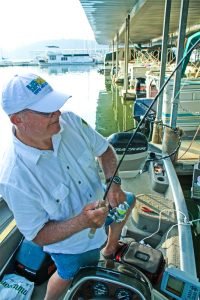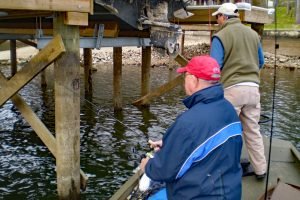Dickey Porter demonstrates proper “dock shooting form.” It takes practice to perfect the art of skipping tiny crappie jigs up underneath shaded docks, but the technique can pay huge dividends. (Photo: Richard Simms)
Reaching Crappie that are Hard to Reach
Shooting docks – by fine-tuning their gear and their technique, crappie anglers can reach crappie that are otherwise out of reach.
by Ed Mashburn
Twenty years ago, most crappie fishermen had never heard the term, “shooting docks.” Now, even if they’ve never done it, most have heard of it.

The principal is basically to turn your fishing rod into a slingshot, literally “shooting” tiny jigs up underneath boats docks or other structure that would otherwise be impossible to fish. It is an outstanding summertime technique because docks crate huge areas of shade, often near deep water, and crappie congregate en masse in the shade. Sometimes the hotter and sunnier the weather, the better the fishing.
Captain Lee Pitts is a full-time fishing guide and tournament angler based on Lake Weiss in Alabama. He is a master at dock shooting for crappie.
Equipment
There is no single best set up for dock shooting. Every dock shooter has different preferences. The key is to pick one fishing outfit and sticking with it consistently. You need to experiment to find the best length and weight of rod which works for you.
Captain Pitts believes, “The equipment makes all the difference in the world. The better the equipment, the more precise and accurate an angler can shoot docks. It’s not always the most expensive gear, either. Lew’s has a very affordable combination – the Lew’s Wally Marshall Speed Shooter combo that sells for about $60, and it’s a fine set up.”
Pitts explains why different anglers might have different rod preferences.
“It will be different for each angler. The rod needs to fit the angler. I’m six-foot, five-inches tall, so I am comfortable with a six-and-a-half to seven-foot rod for dock shooting. A shorter angler might be better with a five to five-and-a-half foot rod.”
Dickey Porter, an avid CrappieNOW reader and expert Tennessee crappie angler said, “If I am dock shooting, I prefer a rod that is five-feet long or five-and-a-half at the most. I like to get really close to docks when I am fishing them, but some of my friends like to stand off and use longer rods.”
Light line is best for shooting docks. Six-pound test is as big as you would want to ever use but many anglers prefer 4-pound line, or even 2-pound line.

“I like four to six-pound Vicious Hi-Viz line,” said Pitts. “I can see where the bait is going when I’m skipping it under a dock, and since the bite when dock shooting is often very subtle, the Hi-Viz line lets me see the bite. Even in clear water, crappie don’t mind the Hi-Viz line. If it’s super clear, I may have to drop down to four-pound Hi-Viz line.”
Choosing the proper jig head when shooting docks can make a big difference. Captain Pitts says he prefers 1/32 to 1/24 ounce jig heads. He says the color of the jig head is not crucial most of the time. Most days, the crappie will like one color over all others. If the bite slows, I’ll change colors and heads, and this will often fire the bite back up.”
Technique
Dock shooting is not an easy “pick it up and do it” technique. Dock shooting requires practice to ensure best results.

“Dock shooting is like shooting a bow and arrow,” said Capt. Pitts. “For accuracy and distance, it’s crucial to keep everything consistent. For instance. I always like to use the same length of line when I’m shooting docks. I like the bait to be a foot ahead of the reel when I hold it straight up. I do this every cast.”
Consistency is important. When dock shooting, crappie anglers need to try and keep everything the same for each cast. The angler’s position in the boat, the angle of the rod when it is bent and loaded for the release, and the exact same release point for each cast are all very important for best long-distance shooting. The smartest thing you can do is practice at home before going to the water.
Pitts says, “Lower yourself. Don’t stand straight up in the boat when you dock shoot. The lower you can be when you shoot the dock gives your jig a flatter trajectory and the farther your bait will skip under the dock.”
Pitts says he is partial to Bobby Garland Baby Shad, Slab Slayer and Dock Shooter bodies. These lures have small profiles and flat sides, and they skip well. Also, they give a more subtle presentation to the crappie when they sink. There’s not a lot of appendages hanging off these lures to complicate the skip and distance.”
Dock Choice
Even if a crappie angler has the best gear, the best dock shooting technique, and the best intentions, none of this will matter if the angler doesn’t fish in the right spots. Porter generally prefer docks that are located near deep water. He says, however, that sometimes it is an inexact science. There can be two seemingly identical docks sitting side-by-side. One will hold crappie and one will not.

“I have found that in any particular cove or slough that has numerous floating docks that the crappie will be found under only one or two docks in the entire cove,” said Porter.
He also knows that once you find a dock holding good numbers of crappie, file it away in your memory banks (or as a waypoint). Good docks will often be consistent producers year after year.
“I have come to really like floating docks for shooting,” said Pitts. “Even floating docks in 25 feet of water can be very productive. I like docks which have pontoon boats tied to them. I’ve found that the baitfish will stay close to the pontoons and eat algae and other growth off the pontoon and dock floats, and the crappie will be up shallow chasing the bait.”
Modern conveniences such as Garmin LiveScope or side-imaging can make locating good catchable crappie under docks more efficient.
“I do use electronics,” said Pitts. “With the new side-scan units, you can really dial in and find the crappie under docks. I don’t always look for the most fish under docks, but I do look for structure that I can fish. If there is a big wad of crappie holding on a brush pile far under a dock that I can’t reach, there’s no reason to try and fish that location.”
So as the temperatures climb this summer don’t believe there aren’t crappie to be caught. There is an excellent chance they are just hanging out in the shade waiting on your jig to drop by.
But here CrappieNOW Editor Richard Simms and his friend, Dickey Porter, demonstrate how and why dock shooting works so well on video. We hope you will watch and learn.
(Ed Mashburn is a retired public school teacher, outdoor writer and photographer. He lives in southern Alabama, but he fishes for anything – carp and trout in Arizona, smallmouth bass and crappie in Wisconsin to snook and snapper in the Florida Keys.)



